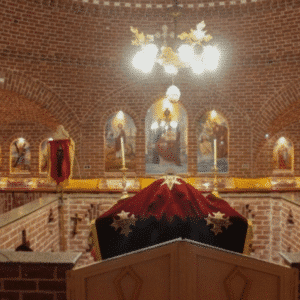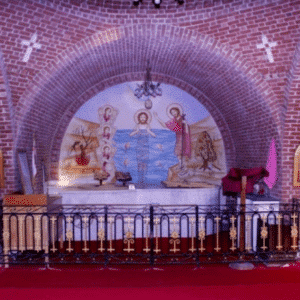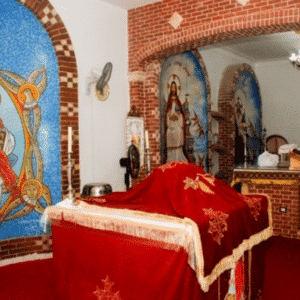St. Moses The Strong’s Monastery, Alamein Road
St. Moses The Strong’s Monastery, Alamein Road
Located at 110-km marker of the Wadi Natrun/El-Alamein City Road, and is about 25 km from the Cairo-Alexandria Desert Road
The monastery is one of the most beautiful monasteries recently established. It adopted the style of ancient monasteries in its churches that are beautiful architectural masterpieces and are full of aesthetics taken from Coptic art. It is the first monastery in Egypt bearing the name of the great saint, Abba Moses the Strong, thanks to our reposed father Pope Shenouda III who encouraged the establishment of a monastic community in this place, bearing the saint name
– Minaret (tower): it is one of the smallest, most beautiful and simplest minarets in Coptic ecclesiastical architecture
– Baptismal Font: in the form of a cross, which is the symbol of our salvation. It has an apse in the East as it is the case in sanctuaries that has a wonderful icon of Christ being baptized by St. John the Baptist in the Jordan. It also has 2 altars, on the north in the name of St. John the Baptism and on the south in the name of St. Wannas
– Monks’ cells: each cell is equipped with the necessary facilities for the monk to enable him to live in solitary
– Library for monks: to preserve books, and provide an opportunity for monks to obtains desired books
– Guest house: equipped with a kitchen to host visitors
– Clergy house: to host His Holiness the Pope, bishops, priests, and monks
– Retreat House: to host youth for spiritual retreats in the monastery
– Center for Finance and Archives: to preserve important documents
The churches have a unique architectural design of domes. Our passion for the patristic heritage is what prompted us to build churches using domes as it was done in the Coptic Church in the early days. The dome to Copts is the preferred model for churches’ ceilings, and all churches have a dome above its main sanctuary. The dome or the “shekhinah” (askena) is a word of Hebrew origin that refers to the divine presence. There are eleven altars in the monastery.
1- Abba Moses the Strong Church: on the shape of a cross, and like the churches of the monastery, its wall are red bricks incanted with white mortar, depicting a magnificent beauty and filled with crosses such as the cross of the Passion or pointed that refers to the Lord’s Passion, or the Latin Cross that refers to the spread of Christianity in the four corners of the earth. It has three altars: (1) the main altar of Abba Moses the Strong, the patron saint, (2) the southern altar of St. George, and (3) the northern altar of St. Abskheron of Qalin. The church has relics for Abba Moses the Strong, St. George, St. Abskheron of Qalin, and St. Mina
2. Church of the Heavenly: we see a unique style of ancient churches, as it has a central dome that resembles a circle and is surrounded by four half domes in the corners of the church
3. Archangel Michael & Abba Shenouda Church: its architectural style is similar to crypts, an engineering architectural style that was preferred in desert churches. By looking at ancient documents of the time of persecution, we found that churches were built in crypts underground. The church has two arches covering the nave in the form of a ship as it is a symbol to the Church that lifts us up to heaven, the harbor of peace
4- Virgin Mary & St. Mark the Apostle Church: it is the largest church in the monastery, and it used to have one altar on the name of St. Mark, then it was renovated and expanded to include two more altars, one for the Virgin Mary, and another for Abba Karas and Abba Bishoy. The three altars raise on the level of one step above the ground, with an iconostasis of fine Coptic style of ancient churches that has two small windows, reminding us of the tradition of keeping the holy sacraments always in the sanctuary. The iconostasis is made of mortar like that of the Church of Hagia Sophia in Constantinople that was built by Emperor Justinian I in the sixth century. There is a cafeteria/visitor’s lounge that is called “Al-Doxar” in monasteries in reference to the tradition of the aghapy table/meal known at the time of the Apostles, which disappeared from church long ago, yet in Egypt it was preserved in monasteries
Abbot: Bishop Saweros
– The monastery was officially recognized by the Holy Synod in its session on June 16, 2016, led by H.H. Pope Tawadros II

















